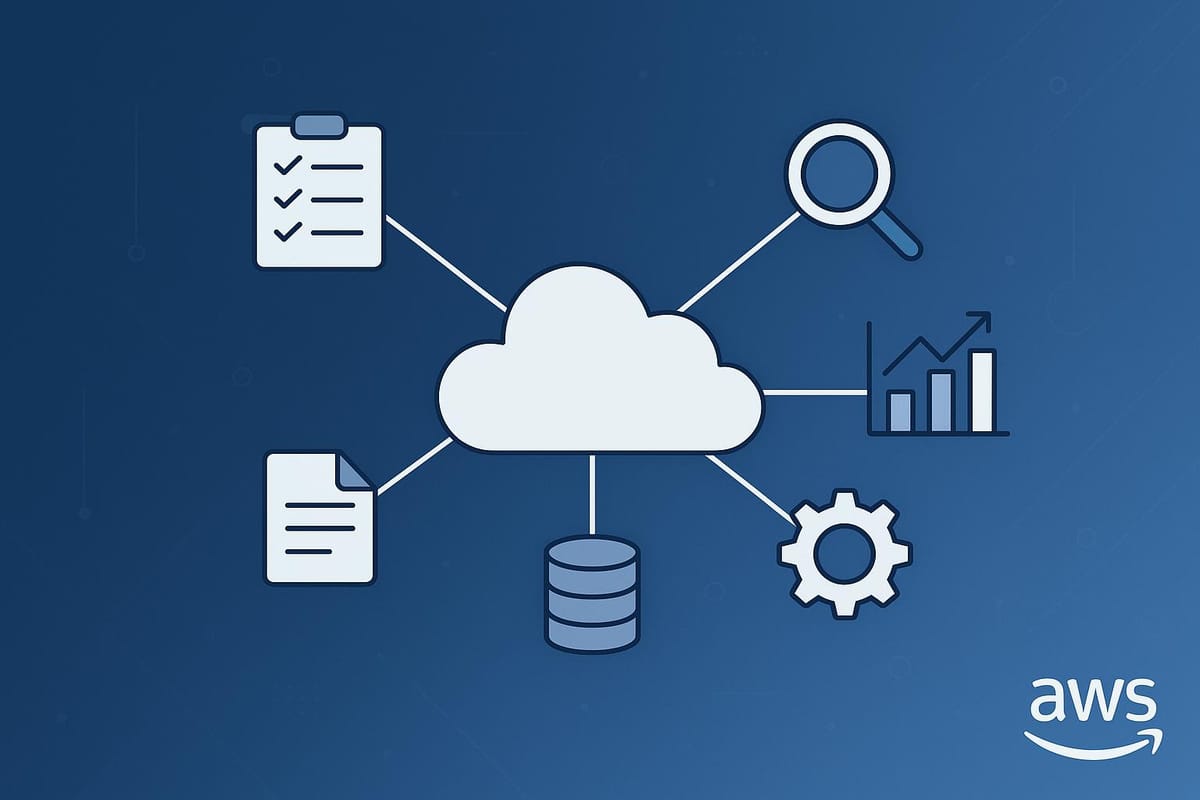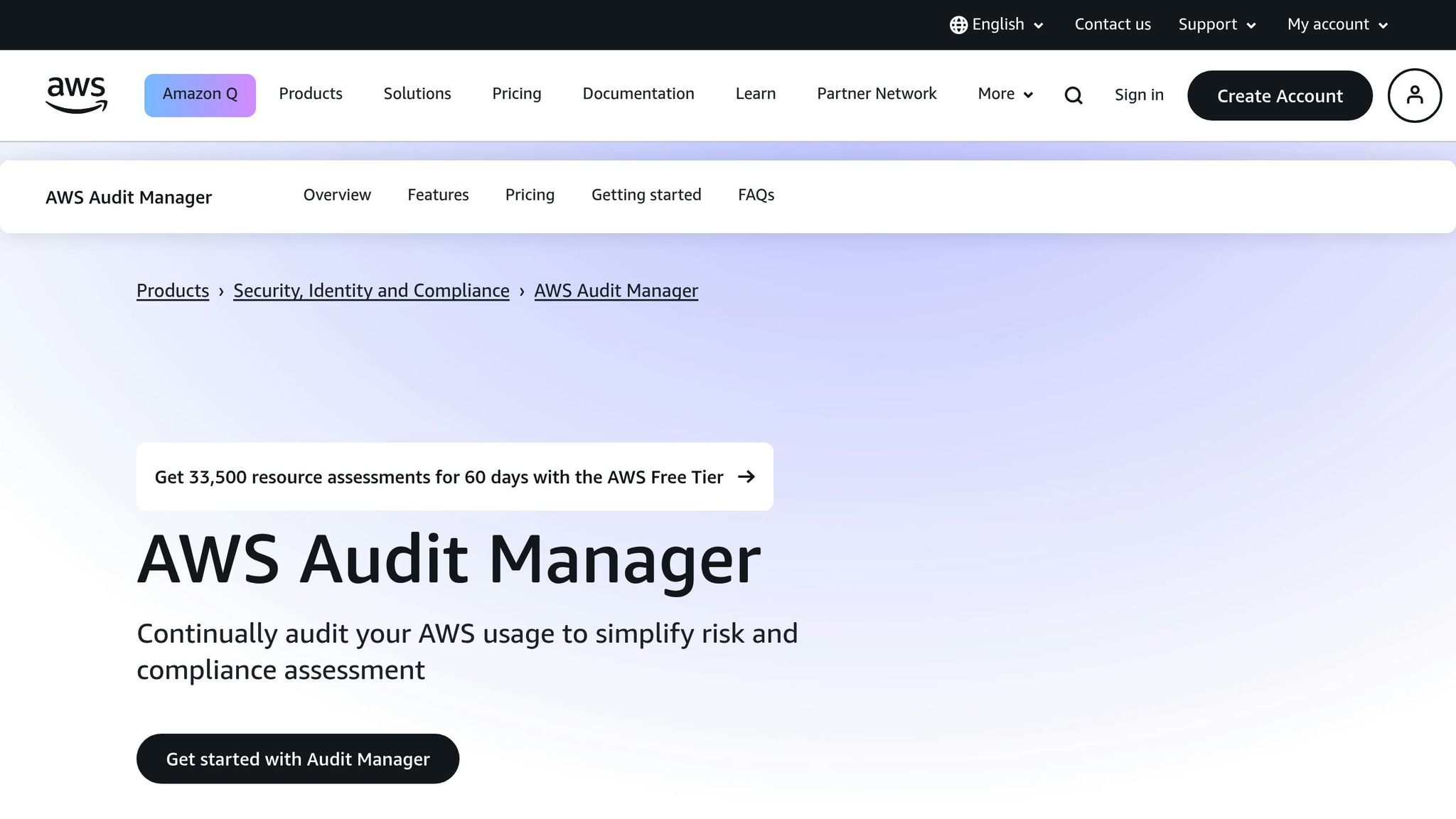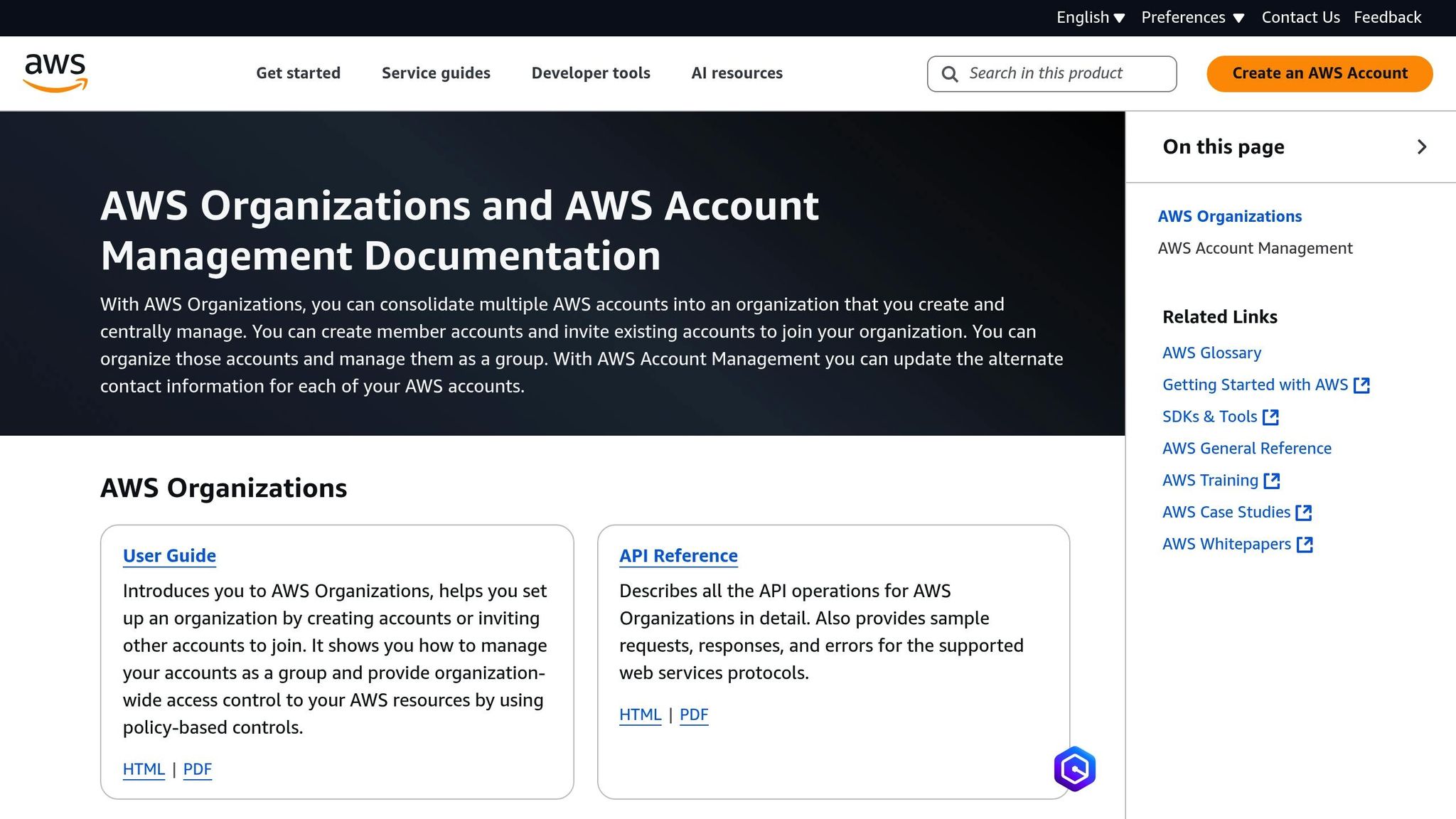5 Steps to Automate Compliance with AWS Audit Manager
Learn how to streamline compliance with AWS Audit Manager through automated evidence collection, real-time monitoring, and report generation.

AWS Audit Manager helps small and medium-sized businesses (SMBs) automate compliance tasks. It collects evidence, monitors resources, and prepares audit reports for frameworks like GDPR, ISO 27001, PCI DSS, and HIPAA. Here's how you can use it effectively:
- Set Up Audit Manager: Choose pre-built compliance frameworks and configure AWS services like AWS Config, Security Hub, and CloudTrail for evidence collection.
- Enable Multi-Account Audits: Use AWS Organisations to centralise compliance across multiple AWS accounts and apply resource filters for better tracking.
- Automate Evidence Collection: Schedule daily compliance checks with AWS Lambda and secure evidence using Audit Manager’s managed storage.
- Monitor Compliance Status: Build CloudWatch dashboards and set up alerts to track your compliance in real time.
- Generate and Store Reports: Customise reports for UK standards, store them securely in S3, and redact sensitive data where necessary.
AWS Audit Manager can reduce audit preparation time by up to 80%, helping SMBs focus on critical tasks while maintaining compliance.
| Feature | Traditional Method | AWS Audit Manager |
|---|---|---|
| Evidence Collection | Manual, periodic | Automated, continuous |
| Resource Requirements | Dedicated compliance team | Minimal staff oversight |
| Framework Updates | Manual implementation | Automated adaptation |
| Audit Preparation | Weeks to months | Near real-time |
How To Use AWS Audit Manager Tutorial for Beginners

Step 1: Configure AWS Audit Manager
Setting up AWS Audit Manager is the first step towards automating your compliance processes. Start by choosing the right frameworks that align with your organisation's compliance goals.
Choose Your Compliance Frameworks
AWS Audit Manager offers a library of pre-built frameworks tailored to various regulatory standards. These frameworks act as templates to guide your compliance efforts.
Here are some frameworks particularly relevant for organisations in the UK and EU:
| Framework | Primary Use Case | Key Controls |
|---|---|---|
| GDPR | Data Protection | Privacy Controls, Data Processing |
| ISO 27001 | Information Security | Security Management, Risk Assessment |
| PCI DSS | Payment Security | Card Data Protection, Access Controls |
| Custom Framework | Organisation-specific | Customisable Controls |
Note: While Audit Manager collects evidence to support compliance, it does not evaluate compliance itself.
Set Up Evidence Collection Services
To automate evidence collection, configure the following AWS services:
- Enable AWS Config: Activate it in all accounts and regions to track resource configurations.
- Set Up Security Hub: Enable relevant security standards to monitor and improve your security posture.
- Deploy Conformance Packs: Align these packs with the framework you’ve selected to automate compliance checks.
Link Controls to AWS Services
To collect evidence effectively, connect your audit controls to AWS services. Here are a few key integrations:
- CloudTrail: Tracks management console activities, such as monitoring MFA usage across your AWS environment.
- Security Hub: Conducts security checks by verifying AWS Config activity across your organisation.
- S3 Policy Monitoring: Evaluates S3 bucket policies against security requirements using AWS Config.
Once these configurations are complete, you’ll be ready to move on to setting up multi-account audits in the next step.
Step 2: Set Up Multi-Account Audits
Now that you've set up Audit Manager, it's time to expand its reach by enabling multi-account audits. This step helps centralise evidence collection and streamlines compliance management across all your AWS accounts.
Connect AWS Organizations

To integrate AWS Organizations with Audit Manager, follow these steps:
- Enable all features in AWS Organizations to unlock full functionality.
- Set up trusted access between Audit Manager and your AWS Organizations.
- Assign a delegated administrator account to act as the central hub for managing Audit Manager resources.
Using a delegated administrator account provides better security and accountability compared to relying on the management account directly.
Apply Resource Filters
To track compliance more effectively, use resource filters. These filters help categorise and manage resources based on specific criteria:
| Filter Type | Purpose | Implementation |
|---|---|---|
| Environment Tags | Differentiate production, staging, and development environments | Apply mandatory tags to all resources |
| Cost Centre Tags | Monitor compliance costs by department | Automate tagging with AWS Config |
| Compliance Level Tags | Identify resources with specific compliance needs | Enforce using tag policies |
| Application Tags | Organise resources by service or application | Inherit tags from parent resources |
Ensure tag policies are enforced across all accounts to maintain consistency and accuracy in compliance tracking.
Set Up IAM Roles
To manage cross-account evidence collection, configure these IAM roles:
-
Service-Linked Role
Create theAWSServiceRoleForAuditManagerrole and attach theAWSAuditManagerServiceRolePolicy. This role allows Audit Manager to automatically gather evidence from your accounts. -
Administrator Role
Use theAWSAuditManagerAdministratorAccesspolicy for accounts requiring full administrative access to Audit Manager. -
Custom Roles
Design custom IAM roles tailored to your organisation's needs, adhering to the principle of least privilege to minimise access risks.
For better security and streamlined access management, consider implementing AWS IAM Identity Center. This centralised solution simplifies user access and ensures tighter control over cross-account permissions.
Step 3: Set Up Automated Evidence Collection
Schedule Daily Compliance Checks
Automate your compliance checks with AWS Lambda functions. These modular functions can be designed to evaluate specific compliance criteria, ensuring your environment stays secure and meets required standards. Here's a quick breakdown:
| Compliance Check Type | Lambda Function Purpose | Trigger Event |
|---|---|---|
| Resource Tags | Validates required tags on resources | AWS Config change |
| Security Groups | Monitors for unauthorised changes | CloudWatch Events |
| Access Permissions | Verifies IAM policy compliance | CloudTrail API calls |
| Data Encryption | Confirms encryption standards | S3 bucket creation |
"AWS Config offers both managed rules (predefined by AWS) and custom rules (user-defined using Lambda functions)"
Use CloudWatch Logs to track the execution of these functions in detail. This helps you quickly identify and address any issues. For a more comprehensive view, integrate CloudTrail logs to capture detailed API activities following your daily compliance checks.
Add CloudTrail Logs
Set up CloudTrail logging to strengthen evidence collection. Follow these steps:
- Create a trail to deliver logs to an S3 bucket.
- Define event filters to capture only the necessary evidence.
- Set appropriate data retention periods to meet compliance requirements.
"Using CloudTrail, you can determine the request made to Audit Manager, the IP address from which the request was made, who made the request, when it was made, and additional details"
Protect Evidence Data
To ensure the integrity and security of your compliance evidence, take advantage of AWS Audit Manager's managed storage repository. This storage provides read-only access and keeps data secure for up to two years. Here's how you can safeguard your evidence:
- Evidence Storage Protection: Use the managed storage repository with strict read-only permissions.
- Report Integrity Verification: Enable automatic checksum generation for report files to verify their integrity.
- Access Management: Implement granular IAM policies, adhering to the principle of least privilege.
Step 4: Monitor Compliance Status
Build CloudWatch Dashboards
Create CloudWatch dashboards tailored to UK formats to keep an eye on real-time compliance metrics. These dashboards should include widgets that display key data from AWS Audit Manager assessments, allowing you to monitor progress at a glance.
| Widget | Purpose | Updates |
|---|---|---|
| Control Status | Displays pass/fail rates of controls | Every 5 min |
| Evidence Collection | Tracks evidence gathering progress | Every 15 min |
| Framework Coverage | Measures compliance across frameworks | Every 1 hr |
| Resource Compliance | Shows resource-level compliance status | Every 30 min |
All metrics should follow UK date formats (DD/MM/YYYY) and operate in GMT/BST time zones.
Set Up Alert Systems
Once your dashboards are up and running, it's crucial to set up alert systems to notify stakeholders of any compliance issues. Use Amazon SNS to deliver notifications based on the severity of the situation:
- Critical Alerts: Immediate notifications for severe compliance breaches.
- Warning Alerts: Daily summaries of potential risks.
- Info Alerts: Weekly updates on status changes.
"AWS Audit Manager assessments can be scheduled to run daily, ensuring that your compliance status remains current".
Track Configuration Changes
AWS Config is a powerful tool to log and track configuration changes that could impact compliance. Here’s how to make the most of it:
- Set up AWS Config Rules to assess the compliance of your resources.
- Develop custom rules to meet your organisation's unique requirements.
- Enable automated remediation actions to resolve issues as they arise.
You can further enhance your monitoring by integrating AWS Audit Manager with AWS Security Hub. This provides a centralised view of your security and compliance posture, helping you adhere to UK regulations like GDPR.
To safeguard compliance data:
- Use AWS KMS to encrypt evidence data at rest and store logs within UK/EU regions.
- Apply granular IAM policies to control access based on specific job roles.
- Keep a detailed audit trail of all configuration changes for accountability.
For small and medium-sized businesses (SMBs) looking to balance costs with compliance, focus on tracking only the most critical metrics and take advantage of AWS free tier services. For more tips, check out AWS Optimisation Tips, Costs & Best Practices for Small and Medium-sized Businesses.
This continuous monitoring approach lays a solid foundation for generating secure compliance reports in the next step.
Step 5: Generate and Store Reports
Step 5 wraps up your automated compliance workflow by focusing on generating reports and securely storing them in line with UK standards.
Modify Report Templates
Customising AWS Audit Manager's report templates ensures they align with UK-specific formatting and conventions:
| Setting | UK Format | Example |
|---|---|---|
| Date Format | DD/MM/YYYY | 15/05/2025 |
| Time Format | 24-hour clock | 14:30 |
| Currency | British Pound (£) | £1,234.56 |
| Numbers | Period for decimals, commas for thousands | 1,234.56 |
Additionally, adapt templates to use UK spelling and terminology, such as "organisation" instead of "organization". Once updated, these templates are ready for secure storage.
Store Reports Securely
-
Set Up S3 Storage
Create a dedicated S3 bucket with server-side encryption using AWS Key Management Service (KMS). Enable versioning and configure retention policies to safeguard your reports. -
Define Access Controls
Apply strict Identity and Access Management (IAM) policies to enforce the principle of least privilege. For example:{ "Effect": "Allow", "Action": ["s3:GetObject", "s3:ListBucket"], "Resource": ["arn:aws:s3:::compliance-reports/*"], "Condition": { "IpAddress": {"aws:SourceIp": "UK-OFFICE-IP-RANGE"} } } -
Enable Logging
Use AWS CloudTrail to monitor access and changes to your reports, ensuring full traceability.
Remove Sensitive Information
To protect sensitive data, implement automated filtering processes:
| Data Type | Action | Replacement |
|---|---|---|
| Personal Data | Redact | [REDACTED] |
| Account Numbers | Mask | XXXX-1234 |
| API Keys | Remove | [REMOVED] |
| IP Addresses | Partial Mask | 192.XXX.XXX.1 |
For example, a Lambda function can be configured to scan and sanitise reports, ensuring sensitive information is handled appropriately before distribution.
Streamline Reporting While Maintaining Security
- Schedule report generation during UK business hours to align with team availability.
- Store reports in EU or UK regions to meet data residency requirements.
- Use approval workflows for handling sensitive compliance data.
- Notify stakeholders with Amazon SNS for updates and alerts.
"AWS Audit Manager automatically transforms collected data into audit-friendly evidence and attaches it to relevant controls, demonstrating compliance in security, change management, business continuity, and software licensing".
For small and medium-sized businesses looking to balance compliance reporting costs with security, check out AWS Optimisation Tips, Costs & Best Practices for Small and Medium-sized Businesses.
Key Metrics to Monitor
Keep an eye on these metrics to evaluate the efficiency of your compliance reporting:
- Time saved compared to manual reporting processes
- Error rates in automated versus manual reports
- Percentage of controls supported by automatically collected evidence
- Response time to compliance issues
Conclusion
AWS Audit Manager is reshaping the way compliance management is handled, offering a more streamlined and efficient process. By combining automated evidence collection with continuous monitoring, it significantly cuts down audit preparation time - by up to 80% - according to recent findings. This means less time spent on tedious manual tasks and more time for teams to focus on strategic priorities.
For UK small and medium-sized businesses (SMBs), the tool provides a tailored solution that aligns effortlessly with both UK-specific regulations and international compliance standards.
| Compliance Aspect | Traditional Method | AWS Audit Manager |
|---|---|---|
| Evidence Collection | Manual, periodic | Automated, continuous |
| Resource Requirements | Dedicated compliance team | Minimal staff oversight |
| Framework Updates | Manual implementation | Automated adaptation |
| Audit Preparation | Weeks to months | Near real-time |
This side-by-side comparison highlights the efficiency AWS Audit Manager brings to the table, making compliance management less of a burden.
Additionally, AWS Audit Manager simplifies the process of turning collected data into audit-ready evidence, making it easier to demonstrate compliance across multiple domains. For more tips on how to make the most of AWS for UK businesses, check out AWS Optimisation Tips, Costs & Best Practices for Small and Medium-Sized Businesses.
FAQs
How does AWS Audit Manager help maintain compliance across multiple AWS accounts within an organisation?
Unfortunately, the source doesn't provide specifics on how AWS Audit Manager handles compliance across multiple AWS accounts within an organisation. However, if you're aiming to make the most of your AWS setup, there are plenty of resources designed for small and medium-sized businesses. These often include advice on cost management, enhancing security, and leveraging automation to streamline operations.
What are the advantages of using AWS Audit Manager for small and medium-sized businesses over traditional compliance methods?
How AWS Audit Manager Helps Small and Medium-Sized Businesses
AWS Audit Manager is a game-changer for small and medium-sized businesses (SMBs) aiming to simplify their compliance processes. By automating tasks like collecting evidence and generating reports, it drastically cuts down the time and effort compared to doing everything manually. This means SMBs can spend more energy on what really matters - their core business activities - while staying aligned with industry standards.
What’s more, AWS Audit Manager offers customisable frameworks and real-time monitoring, making it easier for businesses to stay on top of ever-changing regulations. For SMBs, this translates to better accuracy, lower chances of non-compliance, and significant cost savings when compared to traditional, labour-heavy methods.
Can AWS Audit Manager be tailored to meet unique regulatory requirements not covered by its default frameworks?
AWS Audit Manager provides the ability to tailor its frameworks to fit unique regulatory needs that may not be covered by its pre-built options. You can build custom frameworks by selecting specific controls or uploading your own, ensuring they align perfectly with your organisation's compliance requirements.
This customisation is especially helpful for small and medium-sized businesses (SMBs) that often need to address niche or industry-specific regulations. If you're looking to make the most of AWS for SMBs, exploring expert advice on areas like cost management, security, and automation could prove valuable.




